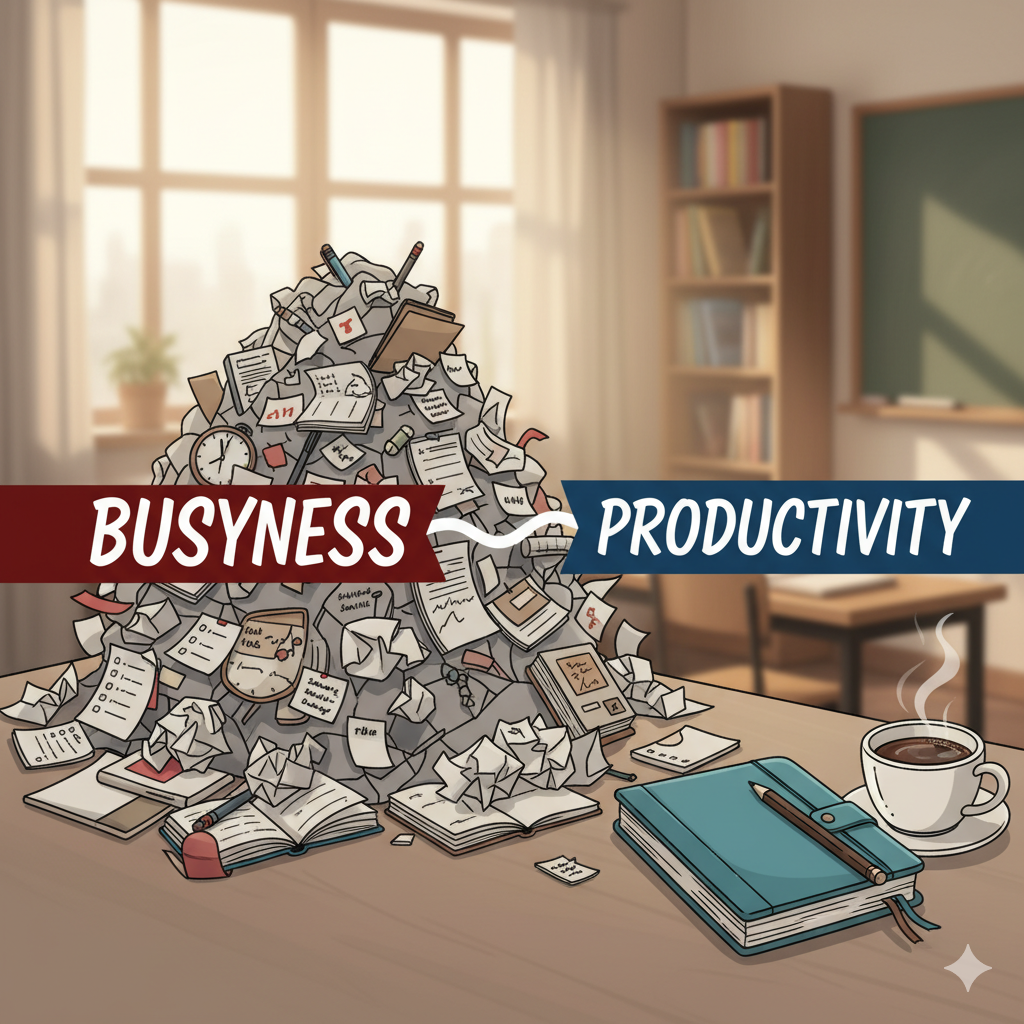Trading the 'Culture of Busyness' for Deep Learning
The start of a new week often brings with it a familiar and powerful undertow: the sheer, relentless pace of school life. For school leaders and educators alike, this experience is almost universal—the overwhelming flood of grading papers, juggling back-to-back meetings, meticulously planning lessons, and managing the countless “extras” that don’t always make it onto our official job descriptions. It’s easy to get caught in this whirlwind, leaving us to question whether the constant frenzy is simply an unavoidable part of being an educator or if it’s actually a symptom of a deeper, systemic "culture of busyness" that quietly drains the energy from both teachers and students. This pattern goes beyond mere exhaustion or the normal stresses of the profession; it forces us to pause and ask when the nonstop motion stops serving our work and instead starts to interfere with the thoughtful, meaningful intellectual engagement we are committed to nurturing. Ultimately, this moment of reflection challenges us to rethink how we structure our time and prioritize deep, focused learning amidst the noise of daily demands.
Deconstructing the Busyness Trap
The modern educational environment, heavily driven by accountability demands, increasingly packed curricula, and the relentless expectation of 24/7 availability, inadvertently creates what can be termed a "hidden curriculum of exhaustion." When every hour of the day is filled to capacity, every task is treated as urgent, and every assignment is primarily measured by sheer quantity rather than meaningful engagement, we unintentionally convey a damaging message: that being constantly busy equals being productive or successful. Yet, as any high-performing professional understands deeply, the world’s most impactful and lasting achievements rarely emerge from a frantic, rushed pace. Instead, they result from focused, deliberate, and intentional effort. This fundamental misalignment between activity and true effectiveness is the first critical barrier we must help our students—and ourselves—recognize and break through. Our ultimate goal as educators and leaders is not merely to help students survive the overwhelming grind but to empower and coach them to truly thrive by prioritizing quality, depth, and intentional learning over endless, unfocused activity.
Actionable Coaching Strategies for Intentionality
Your role goes beyond simply delivering content; you are tasked with modeling and teaching your students the vital difference between mere motion—busy activity—and genuine progress—meaningful advancement in understanding. Helping students grasp this distinction is more than an academic point; it represents an intellectual liberation, freeing them to focus on learning that truly matters rather than just staying busy. To support this transformative process, here are several practical coaching strategies you can introduce directly in your classroom. These approaches will encourage your students to engage deeply, reflect critically, and achieve authentic, lasting learning.
Model and Teach the "Meaningful Learning" Audit
Initiate a thoughtful and engaging conversation with your students about how they perceive "busywork" versus assignments that truly enhance their learning experience. Encourage them to reflect on their daily tasks and consider which activities genuinely help them grow and develop new skills, and which may just fill time without adding substantial value. The purpose of this discussion is to empower students to become more self-aware and critical when evaluating their own workload and study methods. Walk them through a structured process of examining their tasks carefully, helping them clearly identify and differentiate between work that actively advances their knowledge and skillset and work that is more routine or repetitive without meaningful educational impact. This approach fosters a deeper understanding of how to manage their time effectively and prioritize their efforts towards activities that support their long-term academic and personal growth.
For example, encourage students to track their homework assignments over the course of a week, categorizing each task into groups such as "Practice" (applying newly learned concepts), "Application" (engaging in solving novel problems or projects), or "Repetition" (repeatedly doing the same type of problem). If students notice they are consistently completing a large volume of repetitive problems, this observation becomes a fantastic opportunity for a focused coaching moment about studying more efficiently. Together, you might decide that once mastery is demonstrated, they only need to complete a smaller number of problems—perhaps five instead of twenty. This approach not only alleviates unnecessary workload but also encourages smarter, more intentional learning strategies moving forward.
Champion "Less, But Better" in Assignments
We need to take a thoughtful and honest look at the amount of homework we assign ourselves, and encourage our students to adopt this same mindset. Research, including valuable insights from the Challenge Success initiative at Stanford, consistently shows that piling on more homework doesn’t necessarily lead to better student outcomes. In fact, after a certain point, more homework can actually reduce its effectiveness. The key isn’t quantity—it’s quality.
Imagine shifting from assigning three smaller, disconnected tasks to giving one meaningful, well-designed assignment that challenges students to think deeply and engage fully. For example, consider the approach of Ms. Davies, an English teacher who was overwhelmed by the endless cycle of grading full five-paragraph essays every week. Instead of burdening herself and her students with high volumes of work, she introduced “Micro-Drafts.” Each Micro-Draft zoomed in on one specific skill, like crafting a compelling topic sentence or skillfully integrating a quote.
This change didn’t just ease Ms. Davies’s workload; it transformed the learning experience. Students could concentrate deeply on mastering one critical skill at a time, which made their efforts more meaningful and less stressful. Ms. Davies was able to provide thoughtful, targeted feedback that truly helped her students grow. This thoughtful refinement of teaching practice is what it means to teach with surgical precision—focusing effort where it will have the greatest impact, enhancing learning while reducing unnecessary pressure.
Normalize Strategic Downtime and Reflection
The most successful students are not necessarily those who fill every moment of their day with activity or painstakingly log endless hours of study. Instead, they are the ones who engage with their learning in a strategic, mindful, and intentional manner. It is crucial that we, as educators, help our students recognize that taking time for rest, downtime, and thoughtful reflection is far from being a luxury or a sign of laziness; these breaks are, in fact, indispensable and non-negotiable components of effective learning.
During these restful moments, the brain works quietly but powerfully: it consolidates newly acquired knowledge, transfers important concepts from short-term memory to long-term memory, and often makes unexpected connections that can lead to innovative ideas and deeper understanding. These periods of calm enable cognitive processes that active memorization alone cannot achieve.
Encouraging students to deliberately set aside approximately 20 minutes of “quiet focus time” free from digital distractions, immediately following the completion of a significant assignment, can make a profound difference. Think of this as scheduling a study hall—an essential, purposeful pause within their academic routine designed to reinforce what they’ve learned. This practice not only helps students manage their workload more efficiently but also models a highly professional and sustainable approach to learning that will serve them well throughout their academic journey and beyond.
By emphasizing reflection as a critical part of the learning process, we honor the timeless wisdom in the saying, “We don’t learn from experience; we learn from reflecting on experience.” Supporting students in adopting this mindset empowers them to deepen their knowledge, build resilience, and become more adaptable, self-aware learners who are equipped to thrive in an ever-changing world.
Conclusion: The Power of Intentional Teaching
As school leaders and educators, one of the most important lessons we can impart to our students goes far beyond simply increasing the amount of content they learn. What truly matters is teaching them how to be intentional with their time and energy—how to focus deeply and prioritize what truly counts in their academic and personal lives. When we consciously model and guide our students away from the relentless "busyness trap," emphasizing quality over sheer quantity, we help them develop invaluable skills. By encouraging the power of reflection and giving them permission to pause and simply breathe, we aren’t merely helping them manage stress; we are nurturing profound, authentic intellectual growth that will serve them throughout their lives.
You, as an educator, hold the unique power to protect that crucial classroom environment—an environment where true learning happens, not just frantic activity. Be the mentor who supports your students in trading the exhausting sprint of endless tasks for a focused, purposeful marathon of learning. By embracing the philosophy of “less, but better,” you free up essential time that can then be invested in deeper connections and more meaningful, impactful instruction.
This week, let’s commit to making intentional focus our priority. Together, we can create classrooms where every moment counts and where students don’t just move through content—they engage with it in ways that transform their understanding and inspire lifelong growth.


